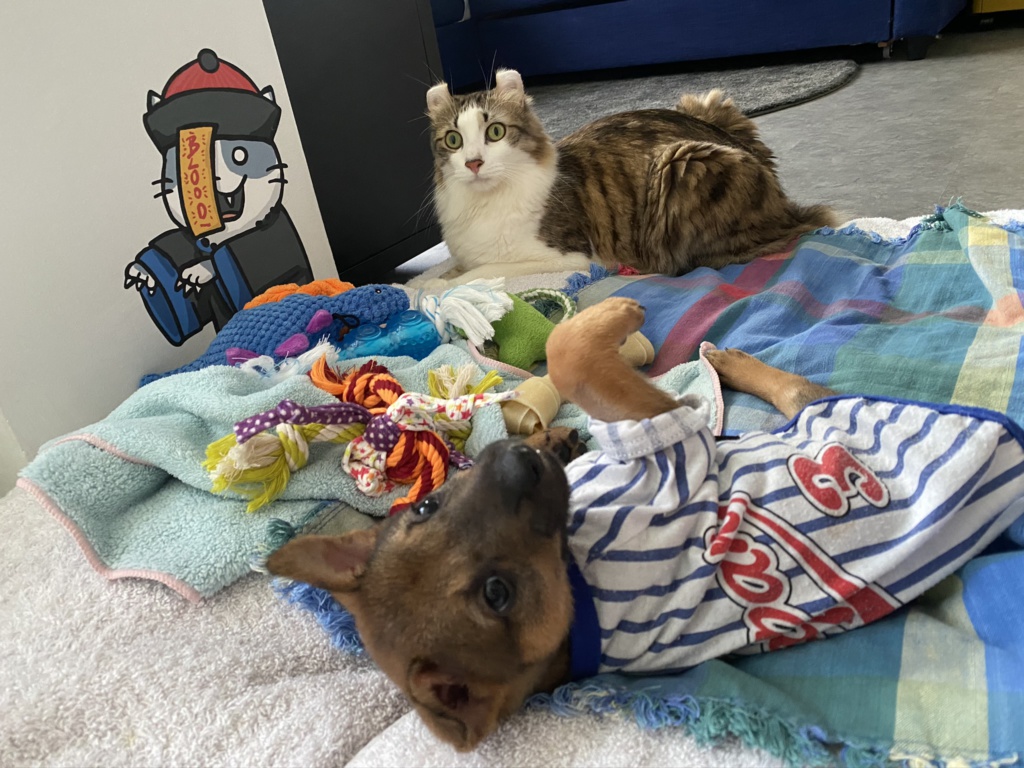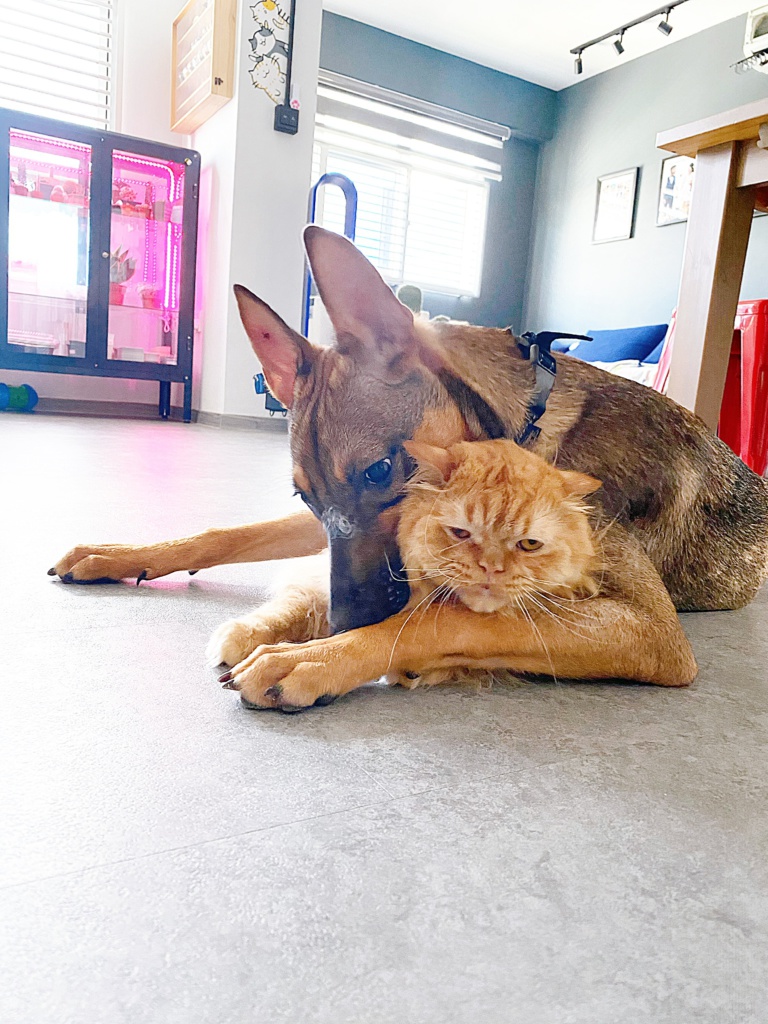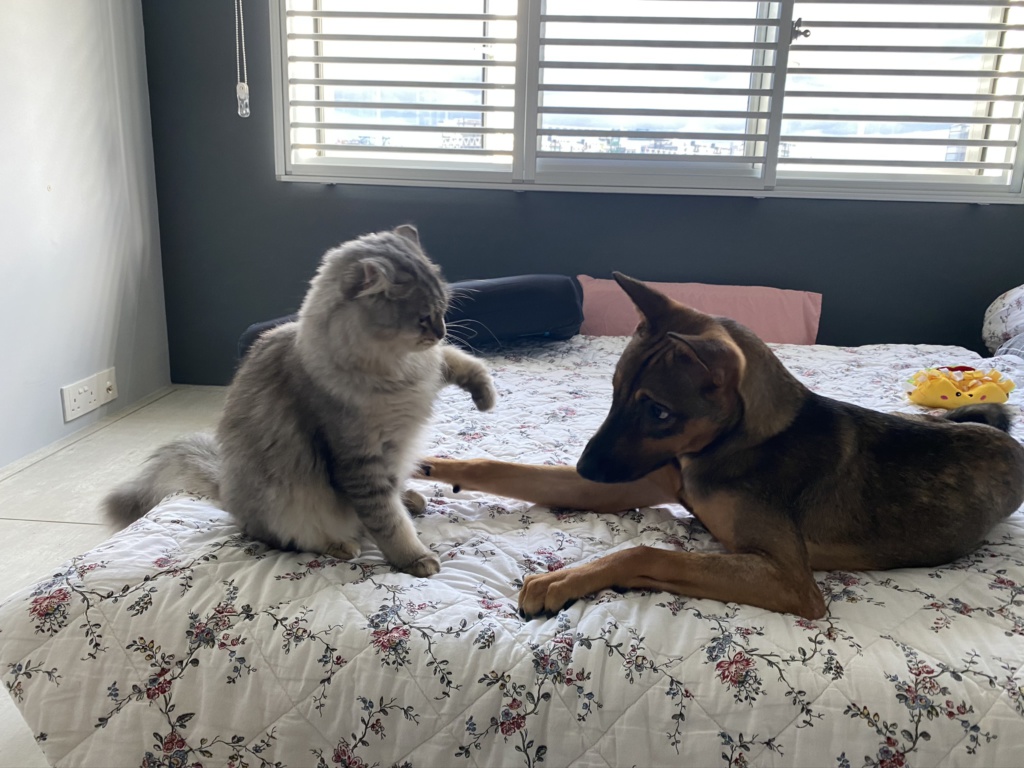I am often asked how to make my new puppy (Kobe) get along with my family cats (Pawsanova 7x)
Today I will reveal some of my own opinions and the homework we have done to get my Tripod Puppy be part of my cat family!
The First Step
The first step in the process of integrating a dog to your cat(s) is to provide controlled safe exposure. The dog must either be in a dog crate or on a leash in the house 100% for a long long time. This period will be weeks but many times it can be months. (We took 2-3months)
There is really no hurry. A gentle introduction is far safer than a rushed one, and will hopefully result in both pets becoming good friends.
I recommend the use of a dog crates if you have space at home. (We use the common toilet as a ‘crate’ instead). The use of a crate is the safest way to make sure you can control the environment. It allows you to focus on the cats while the dog is in the crate.
In the beginning, our cats are put in a separate room before the dog is brought into the house. Always leash your dog while entering a house(Any house, whether is it meet and greet, going to a friend house, or adopting a new pet). This shows them that coming into the house is a controlled experience and not someplace where they can charge around and act crazy.
In other words; you must always be in control of your dog, and the environment you’re in; That’s how accidents are avoided. We don’t leave things to chance. By having the dog on leash, I have control of him if the cat runs and he tries to chase.
People often ask us “When we decided to get dog be off leash and have fun with the cats?” The answer is simple; when you can control the dog under distraction. (Kobe is under obedience training) If you can’t call your dog to you when it is highly distracted by your cat – then the dog is not under your control and it should either be on leash; or in a crate.
In The Crate
Once in the crate the dog is expected to be calm and quiet. If the dog barks at the cats; he got verbally scolded. If they will not stop barking we either close the toilet door (because our crate is the common toilet) The dog was never allowed to be in the house and out of the crate unless it’s on leash. It’s never taken out of the crate (on leash) when the cat is in the room until it has gone ONE WEEK without barking at the cats.
This does not mean the dogs are locked in dog crates for weeks at a time. They can have free (on leash) time in the house but in the beginning the cats are always put in a different room when the dog is out.
If you’re adopting an adult dog and trying to introduce them to the cats, he can be acclimated to a muzzle. We like the rubber mashed basket muzzles because they are less restrictive to the dog. Getting the dog used to the muzzle during these first weeks gives the dog something else to think about other than the cats in the house. After weeks of wearing it in the crate it becomes second nature for the dog to have it on.
When the day comes to allow the dog to be loose in the rooms with the cats it is important to do this while the dog is on leash. If that goes well then have the dog in a muzzle.
Should the adult dog shows the slightest sign of aggression towards the cats it needs to get a correction. The severity of the correction will vary by the temperament of the dog. Some dogs simply need to be told NO !! – while other dogs require a stronger correction.
The correction needs to be strong enough that the dog will remember it the next time it thinks about being aggressive to the cats. If you have been doing your training correctly your dog will be looking at you as it’s pack leader. Pack leaders determine when to use aggression – not lower ranking members of the pack.
If a dog repeated ignores your warnings you have not done a good enough job of establishing yourself as this dogs leader. Should this be the case you need to go back to training and work on that. You might want to work on the dogs obedience training as well.
He will instinctively accept you as pack leader and your position that cats are not prey items to chase and kill.
At some point in time the muzzle must come off.
This should only happen when you are comfortable with your dog’s actions when the dog is on leash and the cats are around. You must have patience. For adult dogs and cats this could take months. With time they will settle into a life style where both sides accept the fact that they now share the same territory.
Dogs and Cats being friends
The best of all worlds is when our dogs and cats become friends.
I need to say that there is a fine line between allowing the dog and cat to get to know one another play together and creating a safe environment. Running in the house should never be allowed, even if it seems to be in play. When cats run this can easily trigger prey drive in the dog.
Cats and Dogs
Some cats accept dogs better than others.

One of our cats (Kovacs the American Curl) become Kobe’s bestfriend immediately when they first lay eyes on each other. They play together, eat and sleep together.


Whereas our another cat Ramsay would jump up and walk away in disgust for months. Over time Enzo became more tolerant towards Kobe and will eventually allow Kobe to be close to him. Kobe has no aggression towards our cats to begin with, we are very lucky. But because he is a big dog, our priority is still our cats’ safety. Prevention is better than Cure.
On the other hand Lokie the Munchkin has never warmed to dogs. He learns to tolerate them on an individual basis, but he will always “hiss” if Kobe come too close.
With a little bit of luck and dedication, you will be able to get your dog and cat to live together in peace. It’s very important to remember to go slowly. No matter how quickly or badly you want it to happen, you have to allow these things to process at their own speed, which can be a snail’s pace over months. The best advice I can give is to error on the side of caution and don’t take chances with your pets lives.
* This blog is designed to be a community where pet owners can learn and share. The views expressed in each post are the opinion of the author and not necessarily endorsed by Pawjourr. Always consult your veterinarian for professional advice.
